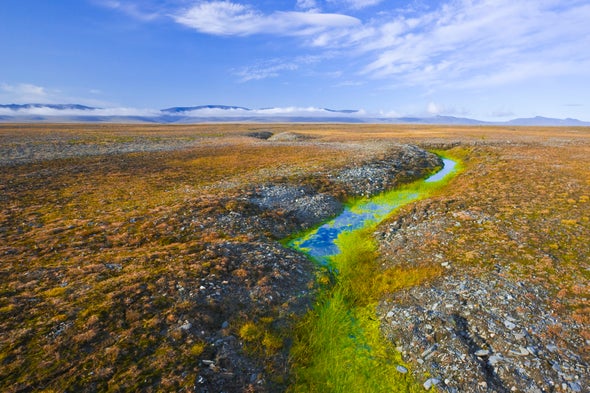Small
Temperature Bumps Can Cause Big Arctic Methane Burps
Warming
can encourage the growth of microbes in permafrost that produce more
greenhouse gases

10
July, 2019
As
temperatures rise in the rapidly warming Arctic, scientists are
growing more and more concerned about the region’s permafrost—the
carbon-rich, frozen soil that covers much of the landscape. As
permafrost warms up and begins to thaw out, microbes in the soil may
release large quantities of both climate-warming carbon dioxide and
methane into the atmosphere, potentially worsening the effects of
climate change.
Researchers
are carefully monitoring the natural emissions from permafrost in the
Arctic. And in recent years, they’ve also begun designing their own
experiments aimed at investigating the way the frozen soil might
react to future climate change.
They’re
finding that even a little bit of warming may cause permafrost to
release significantly higher levels of greenhouse gases into the air.
New
results from one of these studies, published yesterday in Proceedings
of the National Academy of Sciences, suggest that the microbe
communities are the key. Warming can alter the types of organisms
that live and thrive in the frozen soil, favoring microbes that tend
to produce more methane and carbon dioxide.
The
new study relied on experiments from a special research site in
Alaska, where scientists have designed a way to manipulate the
natural landscape to investigate the effects of rising temperatures.
They’ve built special fences that allow snow to pile up deeper on
the ground, forming a kind of insulation and causing the permafrost
below the surface to warm up. Permafrost at the experimental sites
was around a degree Celsius warmer than nearby sites that hadn’t
been insulated.
The
research site—known as the Carbon in Permafrost Experimental
Heating Project—provides a unique opportunity to simulate the
effects of future climate change. In a laboratory setting, it might
be more difficult to exactly reconstruct the natural landscape,
making scientists less sure of their results.
For
the new study, the researchers conducted special forms of genetic
sequencing to determine how microbe communities changed in the warmer
plots. The shifts were apparent after less than five years of
elevated temperatures.
In
shallower layers of the soil, they found an increase in microbes that
produce more carbon dioxide. And in deeper layers, they found an
increase in microbes that produce larger amounts of methane, an even
more potent greenhouse gas. At the same time, methane emissions from
the experimental sites also increased.
The
methane-producing microbes are a particular concern, the researchers
note. Both carbon dioxide and methane have a warming effect on the
climate—but if a greater proportion of the soil’s greenhouse gas
emissions shift to methane, the stronger of the two gases, then the
permafrost’s effect on the climate could be even more powerful than
scientists currently anticipate.
The
study provides experimental support for scientists’ ongoing fears
about thawing permafrost. Throughout the Arctic, researchers are
finding that large swaths of frozen soil are steadily heating up,
sometimes faster than scientists had previously predicted.
The
research also underscores a growing scientific interest in the links
between climate change and the world’s tiniest organisms.
Just
last month, a group of more than 30 scientists jointly published a
statement warning of the many ways that climate change may affect
microbe communities, and the ways that microbes may in turn affect
the progression of global warming.
In
addition to permafrost, they pointed to changes in microbe
communities that affect the ocean’s carbon uptake and the marine
food web, lead to algae blooms, alter the growth of vegetation,
influence agricultural production, and contribute to the spread of
infectious diseases.
The
statement “documents the central role and global importance of
microorganisms in climate change biology,” the authors write. “It
also puts humanity on notice that the impact of climate change will
depend heavily on responses of microorganisms, which are essential
for achieving an environmentally sustainable future.”



No comments:
Post a Comment
Note: only a member of this blog may post a comment.